By Graham Gauld
Bearing in mind the tremendous success of German drivers in Grand Prix racing before WW2, it is baffling that since the inception of the World Championship in 1950, it took 44 years before Germany could claim its first Formula 1 Champion, Michael Schumacher in 1994.
However, Germany has produced many drivers with the potential to do well in Formula 1, but the impetus within German motor racing was more on sports car racing than Formula 1; there were very few German Formula 1 teams save for Mercedes-Benz in the 1950s and to a certain extent, Porsche in the 1960s. It was not for the want of drivers though, and one of them, Hans Herrmann, was one of the most promising and the first immediate post-war star to come out of Germany. I recently had a chance to talk with him.
Hans started racing in the early 1950s sharing an East-German EMW – built using parts and the engine from one of the BMW factories left in East Germany when the Russians swept in.
As was the case in cameras, with Leica, who also lost a factory to the Russians, both factories were put back into business under new names but using all the same equipment. EMW was the “new” BMW and Fed was the new Leica. I have bitter experience of the latter because in 1951 as a 17 year-old I was sold a “Leica II” by a photo dealer in Edinburgh. Then I found out that before they renamed them Feds the old Leica factory had taken out the old tools and started producing cameras under the Leica name and I only found out when I tried to fit a proper Leica base plate on to “my” Leica and it would not fit!
But I digress. In that same year, 1951, Hans Herrmann and his racing driver friend Erwin Baur shared an EMW race car that Baur had bought to race in Germany.
Hans later shared a Veritas Formula 2 car purchased by another leading German driver, Hans Klenk, who had flown Messerschmitt F109’s during World War II, was a talented driver and in 1952 was brought into the Mercedes-Benz team and ran the Mille Miglia with Karl Kling that year.
Hans was born on February 23, 1928 which means he will hit 90 years of age next February but he is a pretty active character with a great memory for detail.
He lost his father, who was murdered in 1936, and was brought up by his mother who had a coffee shop. He promised his mother he would learn a trade but as he admits “When I was a boy my heroes were Bernd Rosemeyer and Rudi Caracciola, the heroes of Auto Union and Mercedes-Benz, and whereas all my pals wanted to be ships captains, pilots or train drivers, I only wanted to be a racing driver. As a result I spent three years training to be a pastry chef! By then World War II was on and you could not get flour, eggs and the like so I never really practiced making cakes and I have never made a cake since!”
In 1951 Hans’ mother realized his ambitions and sold a gold bracelet his father had given her so that Hans could buy a used Porsche 365 1100 which he later updated to a 1500. He did rallies, hill climbs and races with the car and was one of the new young post-war German racing drivers. After winning a race at Nurburgring in his Porsche in pouring rain he was invited to join the Porsche team for the 1953 Le Mans 24 Hour sharing a car with Helmut Gloeckler – whose cousin Walter was known for his modified Porsches – and they finished second in the 1500cc class with a Porsche 550 coupe. As he explained, he originally thought they had won the class but after the race organizers checked their timing sheets the class win was given to the Number 1 Porsche team car of Richard von Frankenberg and Paul Frere.
In 1954 came one of a number of well-remembered events in Hans’ racing career, the Mille Miglia.
This time he was sharing a 550 Spyder with Herbert Linge. All was well until near Pescara and the village of Chieti. Coming round a corner at about 90 mph he was horrified to see not only a railway level crossing but that the bar was slowly coming down. “I could not stop and so I tapped Herbert Linge on the helmet and motioned to duck and we managed to get across as the train was coming.” (Read “When OSCA Met Porsche“)
At this time Mercedes-Benz were well underway in planning a return to Grand Prix racing for the 1954 racing season. Their 1952 season with the 300SLs had shown promise and now a full-scale return at the highest level was planned. They had signed Juan Manuel Fangio and their pre-war driver Karl Kling for the new team but decided to run a third car and needed a driver.
Hans explained to me that when he was young he never tended to get up early in the morning and one morning around 10:00 am the phone rang. He sleepily grabbed it only to find that it was Frau Heinze, the private secretary of Alfred Neubauer the formidable competitions manager for Mercedes-Benz , who said Neubauer wanted to speak to him. “Neubauer said to me, ‘Herrmann we are going to the Nurburgring for three days testing. I have invited Hans Klenk and Paul Frere to test and would you like to join us?’ I was speechless and still tired so did not say anything for a moment and then Neubauer barked down the phone, ‘Well do you want to come with us or not?’ I said of course, of course I am coming, yes I am coming.”
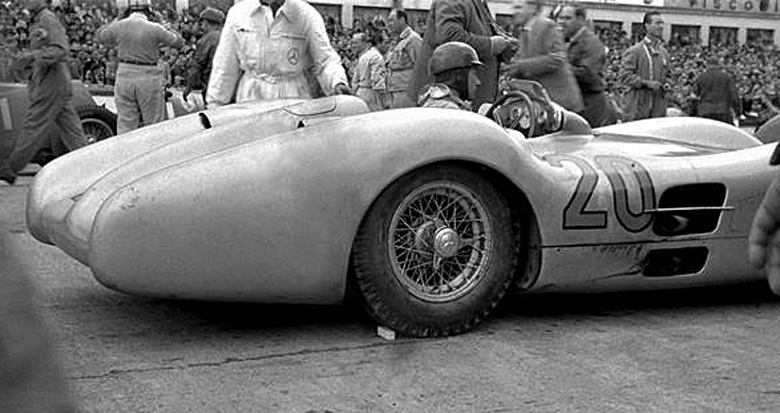
Hans Herrmann on the start line for his first Grand Prix in the streamlined Mercedes-Benz Grand Prix car at the French Grand Prix Reims 1954.
During the test session they were using various 300SLs and Hans Klenk had a big accident which put him out of racing. Herrmann was quickest and was invited to join Fangio and Kling at the French Grand Prix of 1954 with the streamlined Mercedes-Benz W196 cars that cause such a sensation. So Hans Herrmann had his Grand Prix debut with the biggest name in Formula 1, Mercedes-Benz. In the race he set up fastest lap but had to retire. “I had a problem with the engine and tried to get back to the pits but retired. I don’t know what caused it but it could have been that I made a mistake”.
The following year Stirling Moss joined the team and Hans was fourth in the Argentine Grand Prix.
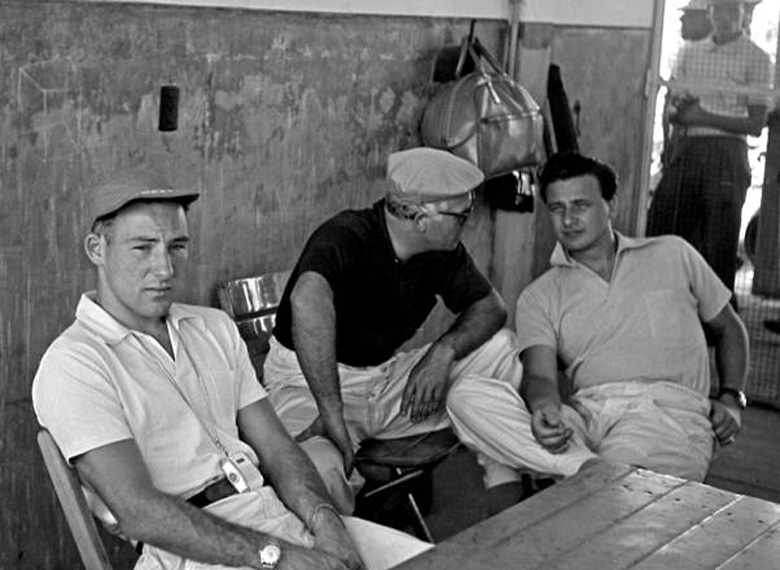
Argentina 1955 a young Hans Herrmann with team mates Stirling Moss and Karl Kling before the Grand Prix.
For the 1955 Mille Miglia Stirling Moss took Denis Jenkinson with him and won outright, Fangio and Kling ran alone with no co-driver and Hans Herrmann took Fangio’s mechanic Hermann Eger with him. In the race Hans caught up and passed Fangio, who had started six minutes ahead of him, and set out for Moss. By Rome Hans was lying third behind Piero Taruffi’s mighty Ferrari and Moss but had had trouble with his throttle. When Taruffi retired it was Moss versus Herrmann but then came disaster.
At the Rome fuel stop the full filler cap was not put back fully and it came off on the Futa Pass and drenched Hans and Hermann Eiger in fuel. Some got in Hans’ eye and he spun off the road and hit a bank. They both leaped out of the car assuming it would burst into flames and then walked to a nearby village to change out of their overalls and into some borrowed pajamas.
Hans, looking back, remarked that he might have had a chance against Stirling Moss because he knew Stirling had been hard on his brakes whereas Hans had been trying to conserve his in the hope that he might catch Moss in the final stages.
His great Mercedes adventure came to an end three weeks later at Monaco when he crashed his Mercedes and was put out of racing due to a back injury.
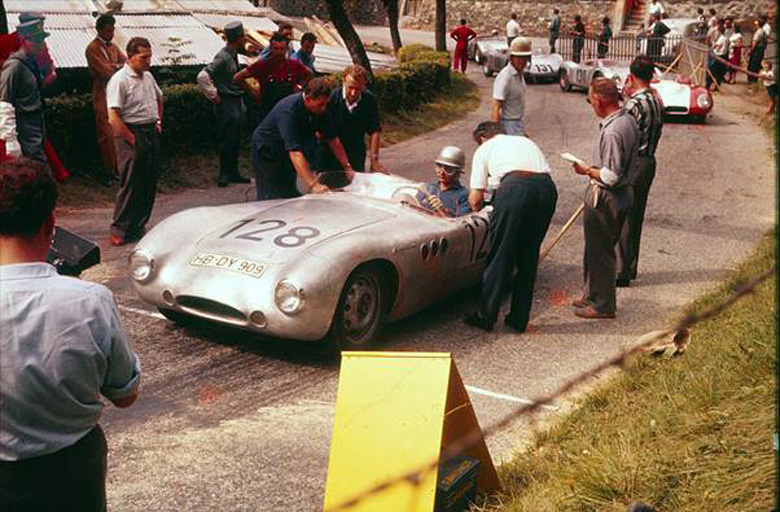
Hans in the Borgward 1500 sports car at Ollon-Villars hill Climb. Wolfgang von Trips, who was driving a factory Porsche, looks over his shoulder from behind the car. Gauld photo.
By 1957 and his return, he was out of the loop but thankfully Porsche offered him a drive at Sebring sharing a 550 Spyder with Wolfgang von Trips, the new German rising star who was becoming a favorite at Porsche. Then for the Targa Florio that year he was offered a drive with Olivier Gendebien in a Ferrari 290 MM but it ended badly as Hans crashed and rolled the car when he forgot that the throttle pedal was in the center and not on the right!
His Formula 1 career was virtually dead in the water but he ran a couple of times in ageing 250F Maseratis for Scuderia Centro Sud and in 1958 there was another blow with Porsche. “Huschke von Hanstein and I had a difference of opinion as he preferred to have Wolfgang von Trips driving for him, but luckily I was approached by Borgward to race their 1500cc sports cars against Porsche in races and hill climbs. Later, von Trips told me I should have offered Hanstein some money!” However Porsche did come back to him that year and paired him with Jean Behra in a new Porsche RSK and they were to finish third at Le Mans, a race Porsche was desperate to win.
Stirling Moss, his father Alfred and manager Ken Gregory had formed British Racing Partnership to obtain cars principally for Stirling to race. One was a P25 four cylinder front engine BRM that was loaned to BRP, was painted in the pale green of BRP. Stirling drove it in the British Grand Prix at Aintree finishing second. However for the German Grand Prix at the high speed Avus track – virtually a dual carriageway with a high banked curve at each end – he chose to drive a Cooper for Rob Walker. With the BRM lying spare the astute Gregory went to the organizers and offered the BRM to Hans Herrmann to drive and the offer was accepted with a suitable financial incentive. In the first heat Hans took things easy as he had not driven the car before and finished 8th. Then in the second heat there was drama. On the seventh lap Herrmann arrived at the South Curve to find that only his rear brakes were working and arrived far too fast and hit the straw bales that launched the car into a series of cartwheels. Hans was thrown out landing on the track and able to watch his car destroy itself. The newsreel of the accident looked horrific and was shown around the world. After the race it was found a brake pipe had broken and BRM were left to haul the wreckage back to England. BRP never ran the car again.
He stayed with Porsche for the 1959 World Sports Car Championship and might have won his class in the Tourist Trophy Race at Goodwood that year but his co-driver Chris Bristow crashed the car.
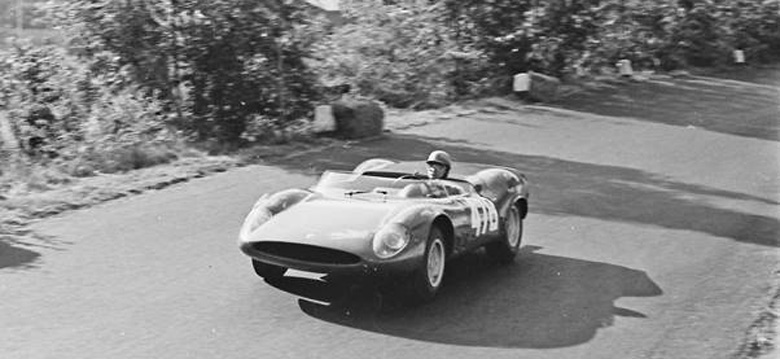
In 1965 Hans was drafted into the Abarth team for the Hill Climb Championship here at Cesana Torinese in Italy.
During the 1960s Hans Herrmann continued with Porsche but in 1965 he was invited to join Abarth for the European Hill Climb Championship . “I found the Abarth was not an easy car to handle. It had a powerful engine and was actually easier to drive on power than the Porsche. In the hill climb events I decided not to extend myself in practice and save some power for the main climb and it seemed to work and on the only occasion I changed tactics and drove as hard as I could in practice. Wolfgang von Trips in the Porsche crashed trying to equal my time.”
By 1970 Hans Herrmann was 42 years of age and for Le Mans that year Porsche had high hopes of their tremendous 917. However the factory team was handed over to John Wyer and Gulf Oil to run at the event which left Hans out of the team. However there was a second Porsche team run by Porsche Salzburg in Austria and owned by the Piech family. Hans was signed to share one of their 917s with English driver Richard Attwood. This was the first year where the drivers started sitting in their cars rather than running across the track and Hans and Richard decided to run a steady race. They were 9th at the end of the first lap but then the rain started and the pair kept a steady pace throughout the night and watched the favored Gulf Porsches and the Ferraris fall by the wayside and their pace was rewarded with an outright win. It was also Porsche’s first outright win at Le Mans.
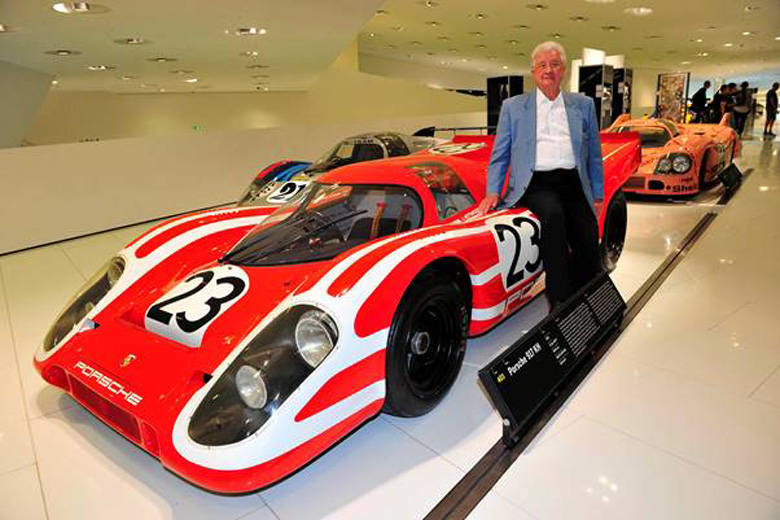
Photographed in 2012 at the Porsche Museum Hans poses beside his Le Mans winning 917 from 1970: It was Porsche’s first outright Le Mans win.
However before the race Hans had promised his wife Magdalena that he would retire if he won Le Mans and he honored his promise. Now he had to face Ferdinand Piech and tell him he was retiring from racing. Piech was annoyed and told him he had a contract with Porsche Salzburg and if he wanted to leave the team it was up to him to find a suitable replacement. Hans turned to the reigning World Formula 1 Champion, New Zealander Denny Hulme, who agreed to take his place and Hans walked away from a sport that had served him well. He had meanwhile set up a big and prosperous automotive parts business and life was good.
In fact, almost too good. In the early 1990s Hans and his wife returned home one night to find three masked men in the house. Hans had his hands tied behind his back and was led down to the cellar. Upstairs the men told his wife they wanted 1 million German Marks to let him go. The next morning two of the gang bundled Hans into the boot of his Mercedes and took him to a service station on the Autobahn and waited until they received a telephone call to say that Magdalena had drawn the money from the bank and then they set off. Magdalena was told where the filling station was and the police prized open the boot and released him. The gang was never found.
Today, at 89, he is always smiling and still follows racing and appears at events usually driving some of the classic Porsches from the Porsche museum.
A happy man, who survived the sport’s most dangerous years.
https://www.youtube.com/watch?v=LQSC3IqJCOk
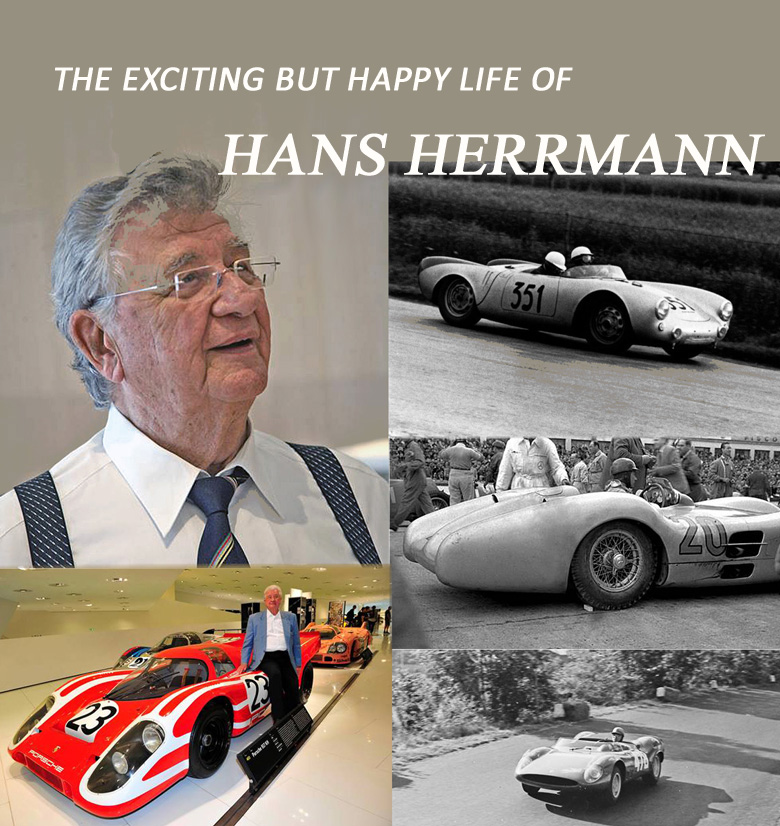
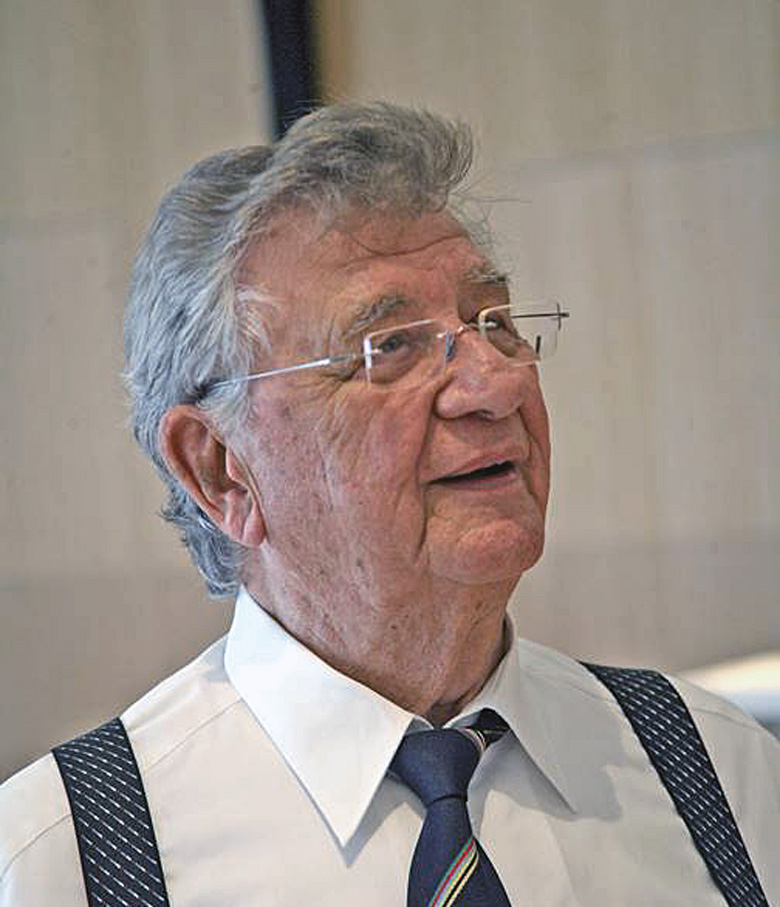
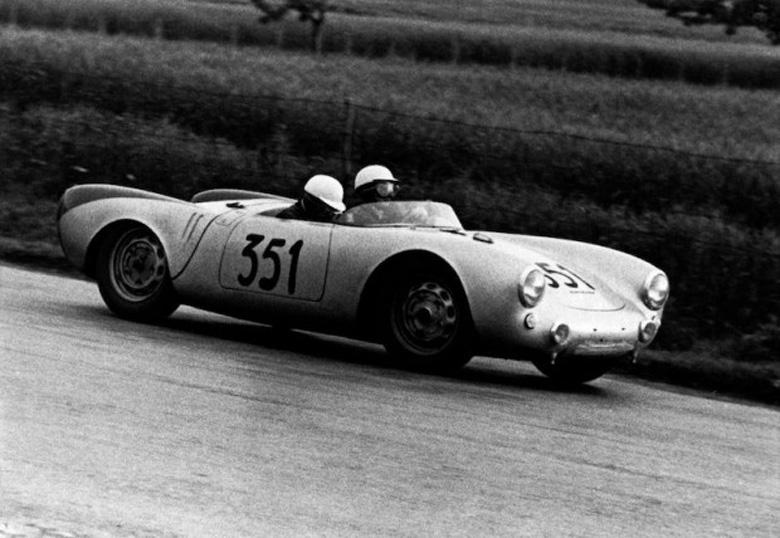
I met Hans Herrmann some years ago during the Classic Days at Schloss Dyck near Düsseldorf. I told him that I fondly remembered his winning drive at Le Mans 70, which I had followed on TV on the eve of my final High School exam. (By the way, the 917 had a 4,5 lit. atmo, not a turbo). He answered: “but did you watch the previous year’s race?” Of course I had! His last stint had been a neck to neck pursuit between him and Jacky Ickx. Jacky won by 120 meters. Hans’ blue eyes were lightning as he was warming-up the engine of the Mercedes F1 car which had left him with a broken femur in Monaco 1955. A couple of years later at the same event, I watched him driving the Mille Miglia winning 300 SLR with no less than Stirling Moss as a co-Driver. Stirling looked slightly bored but Hans was smiling like a child on Christmas day. What a life! What a character!
Another great story from raconteur Graham Gauld. I was at the 1960 Sebring 12 Hours when Herrmann and Olivier Gendebien sped to an unexpected victory in their Porsche RS60–ten laps ahead of the closest Ferrari and part of a 1-2 finish for Porsche. It was when I because a Porsche racing fan that has lasted all these years. Sorry Ferrari friends!
Yes, can one imagine what a handful the 917 would have been had it been turbocharged? We shall correct.
Editor
Like friend Jeff Allison, I saw Hans driving for Porsche at Sebring 12 hour
but it was 1956 and had as co driver young Count von Trips who was making
his first visit to America.
But I only had eyes for another 550 Porsche driven by West Coast men
Jack Mc Afee and Pete Lovely who would actually challenge the works
Porsche for entire 12 hours.
Thanks to Graham for another excellent reminder of such men
Jim Sitz
David Z – Melbourne
Thank You Graham for another wonderful story on the Great Hans Herrman, your word pictures are fantastic, What a Magnificent Era of Motor Sport,
Another great story – thanks Graham. Always something new and not repetitive re-jigged stuff.
Thank you all for your kind comments. Hans is quite a character and still full of enthusiasm and a very active member of the Grand Prix Drivers Club. Fifty years from now how many current Grand Prix Drivers will have the same enthusiasm and contentment ?
My good friend Joe Sheppard was a cohort of Hans ! Joe also was a 550 “Hot Shoe” ! Having owned and raced three separate 550’s. At Sebring in 1960 he piloted a 356 Carrera for Luck Casners Camoradi team finishing ninth overall. He just turned 89 in August….great article